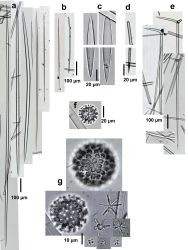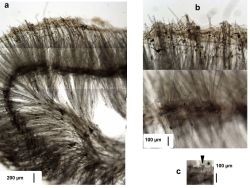orange
bushy
spherical
tough
Martinique
Geodia aff. corticostylifera
Description: Massively spherical, often having a narrow base which makes it appears as a rounded bush; size 5-8 cm in diameter and 5-10 cm in height. The surface is characteristically folded, rather like a brain, with folds and grooves irregular but the deeper ones more or less vertically aligned; ridges rounded and smooth, wormlike or lobed, about 1 cm wide; grooves rounded to elongated, usually narrower. There is an “oscular” orifice at the top, 1-2 cm in diameter, which leads to a deep, cylindrical atrium. Surface tissue is smooth, velvety little fouled, organic. Pinacoderm is orange, except for the edge of the top oscule, which is purple; its color contrast with the internal cream, which is also the color of the atrial lining. Consistency toughly compressible. The skeleton consists of ascending, diverging and interconnecting tracts of megasclere spicules, which tend to fan out near the surface, projecting as palisades that support and pierce the pinacoderm. Tracts generally 3-5 spicules thick, 30-50 µm wide, but looking wider for the degree of packing among tracts. Pinacoderm is 50-80 µm-thick, largely devoid of sterraster or aster microscleres. At about 1 mm below the surface, there is a subsuperficial concentration of pigments, where the triaene megasclere cladomes are aligned with the rhabds pointed downwards, and where a few scattered sterrasters can be seen. Megasclere spicules in three types: (1) Oxea I, slightly curved, fusiform to hastate, slender to stout, more often with both ends acute, smooth or telescopic, but sometimes with one end blunt (anysostrongyloxea), in a great variety of sizes, mostly slender and fusiform, some stout and hastate, 530-1750 µm long and 2.5-22.5 µm wide. (2) Styles and fusiform oxea II, slightly curved; styles are true, with a typical rounded end, and oxeas are fusiform, 340-400 µm long and 2.5-5.3 µm wide; there are some intermediate sizes in between I and II fusiform oxeas. (3) Plagiotriaenes, with short to intermediate but stout and usually acute clades, 25-117 µm long and 3-16.2 µm wide at the base; rhabds stout, elongated and with a slightly blunt tip, 590-1350 µm long and 3.7-22.5 µm wide. Microscleres in two basic types: (1) Sterrasters, round, relatively small, 32.5-42.5 µm in diameter, with relatively large and few spined rosettes, 3.7-5 µm in diameter. (2) Asters in apparently two categories (difficult to discern under light microscopy), with spined rays; large oxyasters with 8-10 slender rays, 12.5-15 µm in total diameter; and smaller strongyl- or oxyasters, some robust some slender, up to 7.7 µm in total diameter.
Notes: This species was found in the open deep reef of Martinique, inhabiting in sand and rubble valleys between corals; it was not observed in the Bahamas and has not been collected in the Colombian Caribbean. It is very similar in overall morphology to Brazilian G. corticostylifera, which S.Z. has seen and photographed in the rocky coast of the Rio de Janeiro State, although our specimens are smaller. In an ongoing morphological and molecular revision of the genus Geodia by Paco Cárdenas (Uppsala University, Sweden), specimens from Curaçao were found slightly different to those of Brazil, suggesting a complex of various species distinguished by subtle differences in morphology and spiculation. This and the fact that the fragments we analyzed from Martinique had very few sterrasters and few styles II, apparently not definitely located in the cortex (both spicule types may have been more abundant elsewhere in the body), led us to name it G. aff. corticostylifera until further study. The upper atrial orifice is not described in the original but our photographs of specimens from Brazil show one or more of these. G. corticostylifera should be compared to G. tylaster Boury-Esnault, 1973, also from Brazil (personal communication of E. Hajdu, Universidade Federal do Rio de Janeiro). The record of G. corticostylifera from Jamaica by Lehnert & van Soest (1996) should be revised as its shape (vase) and color (brownish gray) are not characteristic of this species.
Author Reference: Hajdu, Muricy, Custodio, Russo & Peixinho, 1992
Link: World Porifera Database


